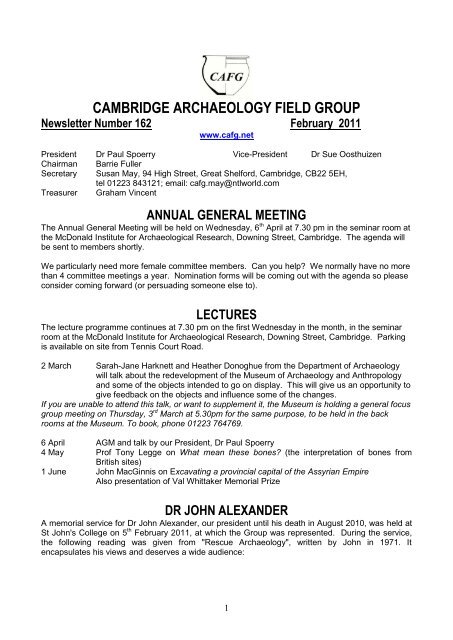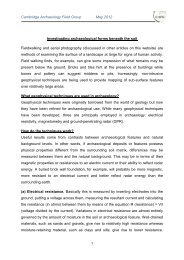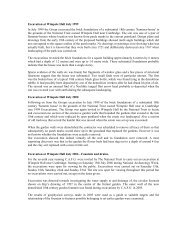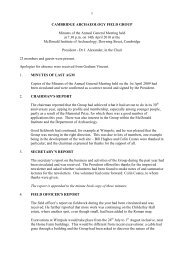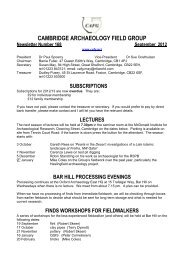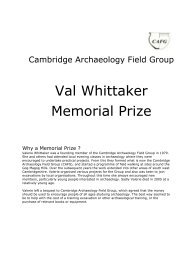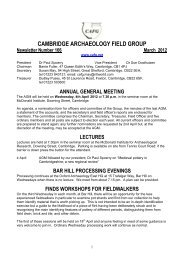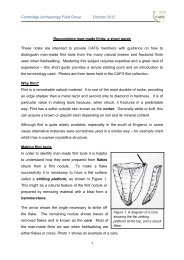CAFG newsletter 162 - Cambridge Archaeology Field Group
CAFG newsletter 162 - Cambridge Archaeology Field Group
CAFG newsletter 162 - Cambridge Archaeology Field Group
Create successful ePaper yourself
Turn your PDF publications into a flip-book with our unique Google optimized e-Paper software.
CAMBRIDGE ARCHAEOLOGY FIELD GROUP<br />
Newsletter Number <strong>162</strong> February 2011<br />
www.cafg.net<br />
President Dr Paul Spoerry Vice-President Dr Sue Oosthuizen<br />
Chairman Barrie Fuller<br />
Secretary Susan May, 94 High Street, Great Shelford, <strong>Cambridge</strong>, CB22 5EH,<br />
tel 01223 843121; email: cafg.may@ntlworld.com<br />
Treasurer Graham Vincent<br />
ANNUAL GENERAL MEETING<br />
The Annual General Meeting will be held on Wednesday, 6 th April at 7.30 pm in the seminar room at<br />
the McDonald Institute for Archaeological Research, Downing Street, <strong>Cambridge</strong>. The agenda will<br />
be sent to members shortly.<br />
We particularly need more female committee members. Can you help? We normally have no more<br />
than 4 committee meetings a year. Nomination forms will be coming out with the agenda so please<br />
consider coming forward (or persuading someone else to).<br />
LECTURES<br />
The lecture programme continues at 7.30 pm on the first Wednesday in the month, in the seminar<br />
room at the McDonald Institute for Archaeological Research, Downing Street, <strong>Cambridge</strong>. Parking<br />
is available on site from Tennis Court Road.<br />
2 March Sarah-Jane Harknett and Heather Donoghue from the Department of <strong>Archaeology</strong><br />
will talk about the redevelopment of the Museum of <strong>Archaeology</strong> and Anthropology<br />
and some of the objects intended to go on display. This will give us an opportunity to<br />
give feedback on the objects and influence some of the changes.<br />
If you are unable to attend this talk, or want to supplement it, the Museum is holding a general focus<br />
group meeting on Thursday, 3 rd March at 5.30pm for the same purpose, to be held in the back<br />
rooms at the Museum. To book, phone 01223 764769.<br />
6 April AGM and talk by our President, Dr Paul Spoerry<br />
4 May Prof Tony Legge on What mean these bones? (the interpretation of bones from<br />
British sites)<br />
1 June John MacGinnis on Excavating a provincial capital of the Assyrian Empire<br />
Also presentation of Val Whittaker Memorial Prize<br />
DR JOHN ALEXANDER<br />
A memorial service for Dr John Alexander, our president until his death in August 2010, was held at<br />
St John's College on 5 th February 2011, at which the <strong>Group</strong> was represented. During the service,<br />
the following reading was given from "Rescue <strong>Archaeology</strong>", written by John in 1971. It<br />
encapsulates his views and deserves a wide audience:<br />
1
"...the complete history of man in this country is only one of the many similar regional studies<br />
elsewhere. They should all be seen as part of an even grander study - the history of man in the<br />
world. Within the last twenty-five years this great project, to which far-seeing historians have always<br />
turned for inspiration, has become possible. This is so important a development that it must be<br />
made more widely known, for a study of the human past, which all races have in common, should<br />
be a unifying factor. Archaeologists all over the world accept common standards of evidence and<br />
common conclusions. This is a promising development for, down the perspective of two million<br />
years, the contributions and experience of all the continents can be seen to have made us what we<br />
are today."<br />
We, as a <strong>Group</strong>, are starting to plan a lecture or lectures in John's memory.<br />
BAR HILL PROCESSING EVENINGS<br />
Processing continues at the Oxford <strong>Archaeology</strong> East HQ at 15 Trafalgar Way, Bar Hill on<br />
Wednesdays when there is no lecture. We meet from about 7.15 pm. A plan can be provided for<br />
those who have not been before.<br />
Could you help with counting and listing the bone from the Wimpole excavations? Identification<br />
skills not needed. If so, please contact Mike Coles.<br />
NEW WEBSITE<br />
The new website will be online very shortly. A summary of decisions about it can be seen under<br />
Committee Meetings. Members will continue to receive emails about imminent events, but we hope<br />
you will use the website as a resource and give your feedback. There will be a “blogs” page, which<br />
all members will be able to use, for questions/answers or new information you want to share. You<br />
will need a log-in name and password – Peter Cornelissen will set these up for you on request.<br />
There will also be a gallery where any member can upload photographs. However, care should be<br />
taken not to use unsuitable pictures, and any containing recognisable children must have their<br />
parents’ consent.<br />
FIELDWORK<br />
We are currently fieldwalking in Toft. Meet in the layby on west side of the road between Toft and<br />
Hardwick at 10 am. Wear stout shoes or boots and clothing for all eventualities. We usually<br />
continue until around 12.30 p.m.<br />
Mike Coles, the field officer, reports on fieldwork so far this season:<br />
At the end of September 2010 we started to look at the fields of Bennell's Farm, Comberton. Colin<br />
Coates had spotted some crop marks on the fields to the north of the farm buildings using Google<br />
Earth and Terry Dymott organised access with the farmer Mr Tebbitt. The fields are on the north<br />
side of the Bourn river valley and slope up to the north. We spent ten Sunday mornings here, and<br />
on the 14 th November, at the highest point, found a scatter of Roman pottery, the usual 2 nd to 4 th<br />
century wares. This site covers no more than 50m east to west and abuts a hedge on the north; we<br />
were unable to properly look at the field beyond as it was sown with oil seed rape. The small nature<br />
of the pottery spread suggests that this is an outlying Roman farmstead, perhaps related to the villa<br />
known at Comberton.<br />
As an interlude from the heavy clay of West <strong>Cambridge</strong>shire, we visited Burwell Fen on the 23 rd<br />
January 2011. Here we looked at the spoil heaps of peat created as part of the management of the<br />
site by the National Trust. We were joined by seventeen members of the public, organised by Lois<br />
2
Baker from NT Wicken Fen, for them to experience some practical archaeology. In the event, on a<br />
cold grey day, we found a small handful of Neolithic struck flint and a bone that was a bovine<br />
astragalus (ankle bone), perhaps of an Auroch. Thanks to the efforts of our members, the visitors<br />
had a good morning and we recovered a few finds.<br />
Then back to the heavy clay, across the Toft- Hardwick road to Wood Barn Farm, again access<br />
organised by Terry Dymott. Six weeks later and we have few finds to report from these large open<br />
boulder clay fields. There was an area near the farm with 18 th and 19 th century pottery and Liz<br />
Tomkins found a superb circular fossil on a large piece of sandstone.<br />
John Waterhouse and Stephen Reed have made great progress in working on record files from<br />
previous sites and we hope that we will be able to lodge copies of them all with the HER in the near<br />
future.<br />
Hopefully the rest of the fieldwalking season will be more productive and rewarding.<br />
Excavation 2011<br />
Dates for your diary: 23 rd July to 31 st July and probably the weekend before, 16 th and 17 th July. This,<br />
as always, will be a group excavation in which all members are encouraged to participate whatever<br />
the level of skill, even if they can only manage to visit the site to see what is found, so please put it<br />
in your diary. This is part of CBA Festival of British <strong>Archaeology</strong> and, as in previous years, we are<br />
likely to be able to undertake an excavation at Wimpole for the National Trust. Terry Dymott and I<br />
will meet Angus Wainwright shortly to discuss last year’s results and any proposal he may have for<br />
this year. [According to the Wimpole Hall events leaflet they are holding their “<strong>Archaeology</strong> in<br />
Action!” weekend on the 30 th and 31 st July and expect to see us there.(Sec)]<br />
Thanks to Robert Skeen, Colin Coates and Emma Smith, and members at Bar Hill on Wednesday<br />
evenings, we have made progress in processing the finds from last year – at the last count we have<br />
recorded 3124 of all sorts.<br />
WIMPOLE EXCAVATIONS 2010<br />
On the 5 th January Mike Coles shared more details of the results of the 2010 excavations at<br />
Wimpole, this time near Home Farm. The background was given in the November <strong>newsletter</strong>.<br />
Further documentary research shows a group of 8-10 houses each in its own plot in the general<br />
area of what is now Home Farm, on the 1638 Hare Map, one of a number of little settlements on the<br />
Wimpole estate. Mr Stokes’ house appears to be in the vicinity of the building uncovered. In 1794<br />
Sir John Soane designed the new state-of-the art farm, including on the plan Mr Ratford’s house,<br />
coloured grey so possibly to be removed. However, the corner of the new barn adjacent to the<br />
house and barns was cut in a diagonal, as if to accommodate them. The house seems likely to have<br />
gone by 1820 and the field has not been touched since its demolition.<br />
Preliminary geophysics by RheeSearch showed a large disturbed area and an earthwork survey<br />
revealed some humps in the field, including a possible hollow-way or ditch. Parch marks appeared<br />
in a sub-rectangular pattern, but not extending as far as the hollow. There appears to have been a<br />
yard to the east of the house, in the angle between the house and its barns. Five trenches were<br />
placed where there were indications of changes.<br />
Trench A, on the east of the site, was placed over the main wall, though this turned out not be a<br />
very solid wall. A cross wall was also present and it is thought that there may have been a<br />
doorway at this point.<br />
3
Trench B, south of A, revealed a substantial brick wall just under the turf, possibly supporting a<br />
timber frame. There was little brick rubble.<br />
Trench E in the south-east corner of the site established the brick corner of the building. Some<br />
stone roof tiles were found.<br />
Trench C, on the south of the site, had more massive brick and clunch walls, which did not match<br />
the wall in trench E. The remains of what was likely to have been a large chimney were revealed,<br />
including a great lump of brickwork which had been tipped in. There had obviously been demolition<br />
and the brickwork may have extended higher, even to 2 storeys. The house might have been similar<br />
to Monument No. 30 at Comberton in the RCHM survey. Wall plaster was also present. There was<br />
also a possible later extension.<br />
Trench D, in the north-west, had an outside wall and a cross wall not lining up with that in trench A.<br />
This trench had a white brick floor outside the main house, an extension clearly built against the old<br />
wall, probably not before 1800, and possibly a kitchen. Some blue painted wall plaster was found.<br />
This extension overlaid and butted up to a midden with apparently 18 th century pot. The midden was<br />
therefore being used after the house was built, possibly as a work/kitchen area or a garden at some<br />
point. There were no finds outside the wall on the east face – possibly a path or yard. Deeper in<br />
the trench there was a layer of cobbles, small giving way to larger, but it was not possible to<br />
investigate below this layer.<br />
The main house had red bricks, but was possibly timber framed above a plinth and the few stone<br />
roof tiles suggest that it might have been part tiled and part thatched. These red bricks suggest a<br />
construction date of 1650/60s, certainly not earlier than the 1640s, possibly after the Restoration of<br />
the monarchy, since the estate owner, Chicheley, was a Royalist and had been imprisoned several<br />
times. The lay-out of the walls suggests the house had one large room, 2 small ones and one more<br />
extending into the next field.<br />
Most of the finds appear to be from the date of demolition, not construction, and there was no late<br />
Victorian nor 15 th /16 th century pottery. However, in trenches A, B and D, Medieval pottery of the<br />
13 th /14 th centuries was found, and in trench B and possibly D, possible beam slots were discovered.<br />
The Medieval remains may be of Mr Stokes’ house on the 1638 map.<br />
Ratford/Radford is a fairly common name. A John Ratford died in 1795, leaving belongings to his<br />
wife but making no mention of a house. Could this have been his house? John had property in<br />
Bourn and in his will, proved in London, refers to a mahogany card table and a wainscott bureau.<br />
He was a carpenter and possibly also a smallholder. His wife died in 1806. It is known that there<br />
was a school in the area, and the discovery of slate styluses and a piece of slate with markings,<br />
makes one wonder if this was that school.<br />
THE STAR-CROSSED STONE<br />
On the 3 rd November, Kenneth McNamara spoke on “The Star-crossed Stone: the <strong>Archaeology</strong> and<br />
Mythology of Fossil Sea Urchins”. His interest in these fossils was sparked by learning of a Bronze<br />
Age grave of a girl and a baby found on Dunstable Downs, where more than 200 fossil sea urchins<br />
(or echinoids) were found surrounding the skeletons, nut none in the other adjacent graves. He set<br />
about tracing the human use of these five-pointed burrowing creatures.<br />
They have been found with the dead, in inhumations, cremations and remembrance barrows, and of<br />
use to the living in practical ways – jewellery or spindle whorls; or for spiritual purposes – lucky<br />
charms, warding off evil. Ken believes that people were attracted by the five-pointed star shape,<br />
possibly as a lucky omen, possibly by its aesthetics.<br />
4
At Swanscombe an Acheulian (400,000yrs BP) hand axe with a fossil urchin has been found, some<br />
of the fossil edge being broken but the other side not worked, and there are examples from the<br />
Paleolithic and Mesolithic of the fossils being used. In the Neolithic they begin to be found<br />
associated with burials, usually one per person and sometimes incorporated into a tool, and this<br />
continues into the Bronze Age. From the Iron Age, two fossil sea urchins have been found with<br />
shapes on the underside similar to the hammer shape on representations of the god Thor: this<br />
hammer was a symbol of creation as well as destruction. The deposition of the fossils in graves<br />
continued into the Anglo-Saxon and Viking pre-Christian periods.<br />
In the Near East the human use of fossil sea urchins has been found from the Neolithic onwards,<br />
including their incorporation into figurines and fossils worked to bring out the pattern; and carved<br />
hieroglyphs of 1700BC at Heliopolis state where the fossils had been found. There are many uses<br />
of the five pointed star in the Middle East.<br />
In folklore the fossils have many names, such as shepherd’s crowns, or fairy loves, a charm to<br />
make bread rise and milk not to go sour. They have also been used as amulets, kept by the front<br />
door or on a window sill up to modern times.<br />
Anyone who missed this talk may like to catch up by attending Ken’s talk with the same title at the<br />
Sedgwick Museum of Earth Sciences on 16 th March at 7pm as part of the <strong>Cambridge</strong> Science<br />
Festival (pre-book). He has also published a book called “The Star-Crossed Stone”, published by<br />
the University of Chicago Press at £18.<br />
LANGLEY ABBEY AND MEDIEVAL BROADLAND<br />
On the 1 st December Dr Paul Spoerry, having first stated that he was very happy to take on the post<br />
of President, which cemented the <strong>Group</strong>’s relationship with Oxford <strong>Archaeology</strong> East, and hoped<br />
that it would be good for all, told us about research into Langley Abbey, by the River Yare on the<br />
Norfolk Broads. The owner of the Abbey wanted to repair it and turn it in to an attraction, and had<br />
asked the Unit to produce a display on the surviving west range.<br />
The area lay on the edge of the Dogger land bridge in the Mesolithic and there are signs of<br />
prehistoric land use. In Roman times the Yare flowed into a wide estuary where Great Yarmouth<br />
now sits. Little of the Saxons has been found at Langley, although this was a wealthy part of the<br />
country. The Vikings had considerable influence, known from the number of freemen/sokemen and<br />
place names, including some along the Yare, which was possibly becoming less estuarine.<br />
Langley became a town with a monastic house under the Normans. The estuary silted up and the<br />
spit of land formed on which Yarmouth was built. The landscape became productive and settled.<br />
Langley had a small parish church owned by the Abbey, which also held the manor. The village<br />
was sited to the south of the Yare and its wetlands, with the Abbey on the edge of the wetland and<br />
the church on high ground to the south. After the dissolution the Abbey became a quarry, partly for<br />
the adjacent big house, but the west range was eventually turned into a mechanised threshing barn.<br />
The current Abbey Farm was built in the 18 th century, the previous house having burnt down.<br />
The Abbey was a Premonstratensian house, canons not monks, although they lived in monasteries.<br />
It was built of flint and, although not much remains, the original layout can be reconstructed, partly<br />
as a result of excavations in the 1920s. It had the classic layout, with the church on the north side<br />
and the cloisters and Chapter House to its south.<br />
Where the first church lay is now flat but part of the 12 th century door has been used elsewhere and<br />
there are remains in the south-west corner of the nave and south aisle. The church was rebuilt in<br />
the 14 th /15 th centuries, with two new chapels and the tower . A new gatehouse was built at that time.<br />
5
There was access over the Chapter House to the church, where there is a trefoil doorway not found<br />
elsewhere, and large windows to the Chapter house enabled lay brothers and servants to listen to<br />
proceedings. Over the cloisters was a possible first floor chapel and also a possible cistern.<br />
The lavatorium was set into the wall of the west range, under a roof. Inside that range was a<br />
vaulted cellar (store) and public parlour on the ground floor, with upstairs likely to be lay brothers’<br />
accommodation: extant doorways provided access to lost buildings and stairs still exist. The abbot’s<br />
quarters were also upstair,s with the only access to the cellar being through them. There may have<br />
been a private chapel over the south aisle of the church, with a door from the abbot’s chamber.<br />
The North gate looked out onto the site of the market and the village grew up outside the Abbey, in<br />
tenements built by the Abbey. 400 items were found detecting in the market area. The Abbey had<br />
its own staithe and barns, fishponds and gardens and also owned various properties in Norfolk. By<br />
1482 the number of canons was reduced to 17, several of whom had duties as priests of parishes.<br />
At Ranworth Church there is an Antiphon which is likely to have been illustrated at Langley but Paul<br />
ended by quoting references to the behavior of the canons, which indicate that Langley was the<br />
most appallingly behaved of all Premonstratensian houses. He commended a visit to this<br />
fascinating building, about which it had been possible to discover so much.<br />
COMMITTEE MEETINGS<br />
Committee meetings were held on the 12 th January and 9 th February. That on the 12 th January was<br />
specifically on the new website. Besides agreeing amendments to the draft pages, we agreed that:<br />
� Any member of the committee may add/edit pages; other members of the <strong>Group</strong> may be<br />
authorised as necessary<br />
� New/revised items must be approved by the controlling editor/s, Colin Coates and Robert<br />
Skeen before going live<br />
� All members of the <strong>Group</strong> may add blogs: log-in names and passwords will be required<br />
� All members should check blogs regularly<br />
� A members’ picture gallery will be available for any member to upload photographs<br />
On the 9 th February we agreed further amendments to the information on the website and that,<br />
when these had been incorporated, the new site should go live.<br />
The treasurer then reported that the financial position was similar to that at the same time a year<br />
before, and the committee will therefore be recommending to the AGM that subscription levels<br />
remain the same. Graham Vincent and Emma Smith both decided that they had to stand down<br />
from the committee and were thanked for their contributions. Robert Skeen and Peter Cornelissen<br />
expressed their willingness to serve. These offers were gratefully received but it was also<br />
suggested that there ought to be more female committee members.<br />
Alison Taylor, former County Archaeologist, had agreed to give a lecture in memory of John<br />
Alexander. The format was discussed and the aim is to hold one event on a Saturday afternoon<br />
during the period February – May 2012, with three speakers, including Alison, to be held in a larger<br />
venue than for our normal lectures. Speakers will be invited to talk either on John’s work or on their<br />
own as it reflects John’s interests. Wide publicity will be needed.<br />
The deadline for applications for the bursary competition is 30 th March this year so no applications<br />
have yet been received, although interest has been expressed. Laura Boxell, one of the 2010<br />
winners, had reported on how she had used the bursary, and it was agreed to add this to the<br />
website.<br />
6
<strong>Field</strong>walking had continued at Comberton and Toft, with one Sunday at Burwell Fen. The field<br />
officer was aiming to find further fen edge fieldwalking to contrast with the claylands, but in the<br />
meantime access to fields on the southern side of Comberton was being sought. Much of the<br />
processing of the Wimpole excavation finds and data had now been completed, but volunteers were<br />
sought for counting and listing the bone.<br />
The first stage of the project to publish a synthesis of fieldwork finds was now coming to an end,<br />
with all the information from 46 sites walked since 1990 gathered in the same digitised format, apart<br />
from some anomalies and gaps to be resolved. The files would be deposited with the HER.<br />
It was decided to affiliate to the <strong>Cambridge</strong>shire Association for Local History at an annual cost of<br />
£10, since this would be another means of publicising the <strong>Group</strong>. We also accepted an invitation to<br />
a planning meeting on the BBC’s Hands on History project<br />
CAMBRIDGE ANTIQUARIAN SOCIETY<br />
CAS lecture meetings are on Mondays at 6.00pm at the Law Faculty, West Road, <strong>Cambridge</strong>, which<br />
members of the <strong>Group</strong> are welcome to attend. The programme continues with:<br />
7 March AGM at 5.45pm, followed at 6pm by Belinda Crerar on The decapitated dead of<br />
Roman London and <strong>Cambridge</strong>shire: a rural/urban divide?<br />
4 April Dr Andrew Reid on Cattle droving and <strong>Cambridge</strong>shire<br />
9 May Mark Hinman on New Landscapes of the <strong>Cambridge</strong>shire claylands<br />
6 June Prof Martin Millett on Rural Society in Roman Yorkshire – recent research<br />
Spring conference: Saturday, 19 th March 2011 From Camulodunum to Durobrivae, aspects of<br />
Roman Life in the Eastern Region, to be held in the Law Faculty, West Road, <strong>Cambridge</strong>. Details<br />
are enclosed or emailed separately.<br />
In addition, up to 20 delegates may join the speakers and others for lunch at Newnham College.<br />
Requests to book a place should be sent to the Conference Registrar, John Stanford 0776 4606682<br />
and places will be offered on a 'first come first served' basis. The hot buffet lunch costs £18.50.<br />
CONFERENCES/COURSES<br />
Courses at Madingley Hall:<br />
3 April Pastures, greens and commons<br />
10 April Moot and hundred meeting places<br />
16/17 April and 14/15 May Introduction to archaeological field survey<br />
20-22 May Religion and beliefs in the archaeological landscape<br />
19 June The legacy of Occupation: bunkers, ghosts and swastikas in the Channel Islands<br />
1-3 July Celebrations of death: an archaeology and anthropology of death<br />
12-14 August Tracing prehistoric ancestry using DNA<br />
12-14 August Artists of the Ice Age<br />
7-9 September Meet the Spartans<br />
Monday, 7 March CBA Winter General Meeting: <strong>Archaeology</strong>, Community, Stewardship. 10.30am –<br />
5pm, British Academy, London<br />
19 March Mummies of Ancient Egypt study day. University of London<br />
29 April Oral personal histories on the themes of Ethology and Primatology , Babbage<br />
Lecture Theatre, Downing Street, <strong>Cambridge</strong>. Free but booking required.<br />
2 – 6 May <strong>Archaeology</strong> survey week. Oxford University DCE<br />
21 May Designing with water: new work in garden history. McDonald Institute, to be held<br />
in the <strong>Cambridge</strong> University Law Faculty. £39 (lunch is not included)<br />
7
<strong>Cambridge</strong> University Institute of Continuing Education classes (all at 7.15pm) from May include:<br />
Mondays: Civilisation: the archaeology of complex society. 9 meetings, 2 field trips. Certificate in<br />
<strong>Archaeology</strong> course<br />
Tuesdays: Working with archaeological materials. 8 meetings, 3 Saturday practicals. Diploma in<br />
<strong>Archaeology</strong> course<br />
Thursdays: From here to eternity? Death and the wider landscape of Stonehenge. 9 meetings, 1<br />
field trip.<br />
The WEA is running a 6 week course Exploring <strong>Cambridge</strong> on foot on Thursdays from 6.30pm<br />
starting on 5 th May<br />
CAMBRIDGE FESTIVAL OF SCIENCE<br />
Besides Ken McNamara’s talk mentioned above, the Festival offers:<br />
19 March, 10am-5pm The archaeology of communication at West Stow Anglo-Saxon village<br />
10.30am-4pm The science of archaeology at the McDonald Institute<br />
EXCAVATIONS<br />
Training and other excavations for this summer are now beginning to be advertised. For details go<br />
to: www.britarch.ac.uk (Council for British <strong>Archaeology</strong>)<br />
EXHIBITIONS<br />
Harborough Museum, Market Harborough – many finds from the Hallaton shrine. It is hoped the<br />
helmet and cheek pieces will join the display in 2012<br />
Sutton Hoo, Woodbridge, Suffolk – Captured on camera: the summer of 1939. Photographs taken<br />
by two visitors. Until 20 March.<br />
British Museum – Afghanistan: crossroads of the ancient world 3 March to 3 July 2011<br />
The Ashmolean Museum, Oxford – Heracles to Alexander the Great: treasures from the royal<br />
capital of Macedon. 7 April – 29 August<br />
NEWS<br />
At Trumpington Meadows, just south of <strong>Cambridge</strong>, the <strong>Cambridge</strong> Archaeological Unit found a<br />
ditch dug around 800BC, to one side of which were many houses and storage pits, and to the other,<br />
only funerary monuments of Neolithic and Bronze Age date.<br />
At Must Farm, near Peterborough, the <strong>Cambridge</strong> Archaeological Unit has found what may be the<br />
oldest basket trap specifically for eels to be identified. It was made in the Bronze Age, around<br />
1100BC.<br />
LIBRARY ADDITIONS<br />
British <strong>Archaeology</strong> January/February 2011 and March/April 2011<br />
CBA Newsletter, December 2010<br />
CBA Conservation Update February 2011<br />
English Heritage Research News No. 15, Autumn 2010<br />
English Heritage Research Review 2009<br />
The <strong>Archaeology</strong> of Animals – Simon JM Davis. Batsford. 1987<br />
Prehistoric Britain and Ireland – J Forde-Johnston. JM Dent & Sons Ltd. 1976 (has plans of many<br />
sites)<br />
Understanding Archaeological Investigation – Philip Barker. Batsford. 1986<br />
8<br />
Susan May, Secretary


